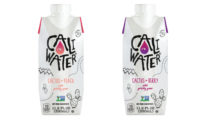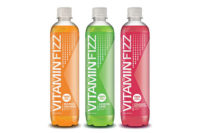Just as the lyrics state, “to keep your engine running you need energy for your high-powered, revved up body machine,” in the educational Schoolhouse Rock! video “The Body Machine,” food and beverage manufacturers are making sure that today’s products are packed with the vitamins and minerals not just to fuel the human body, but also maintain a healthy lifestyle.
The better-for-you beverage trend is contributing to the proliferation of functional beverages, and ingredient suppliers are ensuring beverage-makers have the tools to support it.
“Vitamin and mineral fortification has been reshaping the beverage industry since fortification was first introduced more than a decade ago,” says Luis Ferrey, marketing manager of beverages for Westchester, Ill.-based Ingredion Inc. “Consumers that used to drink beverages, like carbonates or juices, are now looking at other beverage types to provide hydration and other nutrients that the body requires and cannot produce on its own. Better-for-you beverages are perceived by consumers as an option that helps them to maintain a healthy balance of nutrients throughout the day.”
Russ Hazen, premix innovations manager for Fortitech Premixes, Schenectady, N.Y., explains that the value-added platform can be as simple as adding a few nutrients to boost overall wellness or more complex to address specific health conditions such as heart health, bone/joint health, immunity, etc. “Beverages are an ideal vehicle for these healthy additions because of their convenience, and they can easily fit into a daily health regimen,” he says.
Hazen adds that the baby boomer demographic has been proactive about including vitamins and minerals in their diets to ease the normal consequences of aging. However, maintaining optimum health is not limited to one demographic over the other.
“Whether it’s the mom concerned with something like immunity for their children, or an athlete looking to optimize their performance, consumers are actively looking to specific nutrients to enhance their well-being,” Hazen says.
In addition to demographic influences, Ingredion’s Ferrey notes that clean-label trends are driving the usage of functional ingredients.
“The trends of naturally functional and simple ingredients are areas of great opportunity for these beverages,” he explains. “Manufacturers can use vitamins naturally present in juices, like in coconut water for instance, or in fruits by infusing the pulp and then filter it out or even leave a bit to add some fiber. Minerals that are generally present in spring waters are always a great element to tell a story about a specific regional product.”
Conditional support
Although vitamin and mineral fortification has allowed beverage-makers to address some of consumers’ key health and wellness concerns, it also requires an understanding about the functions of individual nutrients to ensure they are supporting the claims brand owners are touting.
For example, fiber, CoQ10, omega-3 fatty acids and resveratrol can be used for addressing heart health, Fortitech’s Hazen says. For blood sugar management/type 2 diabetes, he recommends using fiber as well as botanicals such as green tea extract, cinnamon and ginger, complex carbohydrates and oat beta glucans.
Nutrients such as omega-3s, CoQ10, choline, ginseng, cacopa and phosphydityl serine are popular for cognitive health, Hazen explains. To boost bone/joint health, minerals like calcium phosphorous and magnesium are common choices as are vitamins like D3 and K1, he adds. “Many other compounds potentially help the cartilage matrix and additions such as collagen, methylsulfonylmethane (MSM), glucosamine and chondroitin are all still common additions to products targeting this area,” Hazen explains. “Terminalia chebula, an ancient Ayurvedic plant, is also an emerging candidate for use in products looking to support overall joint health.”
Kathy Lund, vice president of business development and marketing for City of Industry, Calif.-based AIDP Inc., adds that B vitamins can be utilized as an inexpensive additive for energy within beverages.
Encapsulating solutions
Like any product, beverage fortification is not without its share of challenges. To combat this, ingredient suppliers are working with brand owners to protect the final product.
“Stability, clarity and taste are the primary challenges for beverage formulators using vitamins and minerals,” Lund says. “Some vitamins are not water soluble. Special technology needs to be applied to make vitamins and minerals water soluble.”
Made for beverage fortification, AIDP’s enVantec line of products is supported by proprietary microencapsulation technology that does not use gelatin, preservatives or added antioxidants, Lund explains.
“EnVantec provides small particles for greater stability and solubility; perfect for functional beverages and liquid nutraceuticals,” she says.
Fortitech’s Hazen also notes the importance of ingredient protection. “Any ingredient can pose formulation challenges,” he says. “These can include interactions with other ingredients, solubility issues within the beverage matrix or undesirable flavor impacts. The specific form of nutrient selected can be employed to counter these issues. Strategies such as encapsulation of specific ingredients, the manner and timing in which an ingredient is added and adjusting processing conditions during the assembly of the finished product can all contribute to a product’s success or failure.
“A formulator needs to prioritize the benefit of a particular ingredient in a given product,” Hazen continues. “To be credible, the product should offer a minimum concentration of active components to ensure a measurable benefit. It is also easy to focus on active ingredients and overlook the importance of the underlying foundation properties of the product. Many active ingredients contribute metallic or bitter flavors. Leveraging the acidity, saltiness and sweetness of other ingredients should be carefully considered to optimize the product’s taste and flavor profile. Despite the quest for functionality, the single greatest predictor of a new product’s success is taste, not its functional ingredients.”
To ensure efficacy and function, Hazen recommends that beverage-makers consider the product’s processing, packaging and storage prior to consumption. “These factors will have a significant impact on many of the nutritional ingredients added to the system,” he says.
Because minerals are more process tolerant and heat stable, blending, mixing, homogenizing and pasteurization will have a marginal impact on most ingredient forms, Hazen explains. However, formulation challenges still exist.
“[W]here the real challenges working with minerals come into play is in minimizing matrix incompatibilities and nutrient interactions in the product,” he says. “Many of the elemental metals like iron, magnesium, calcium, sodium, etc. are very reactive materials and some of these reactions can cause loss of activity, color changes or objectionable flavors in a finished product.”
To protect the final product, individual premixes or encapsulation of specific ingredients can be administered to create balance and formulation success.
“The selection of appropriate forms of raw material can dramatically impact the success of a premix, and can alter the likelihood of negative interactions, volume of material necessary to deliver the required nutrition, or directly impact the flavor — i.e. magnesium may be magnesium phosphate, magnesium citrate or magnesium lactate, depending upon what other ingredients are utilized in the premix, and the finished product flavor profile,” Hazen explains. “Each individual market form has a specific nutrient activity and solubility in water, as well as a flavor profile and they need to be properly balanced to create a successful formulation.”
For powdered beverages, particle size selection, spray drying, encapsulation or agglomeration are avenues to minimize interactions, assure ingredient solubility and deliver rapid dispersion, according to Hazen.
He adds that the use of vitamins and minerals as well as high-intensity sweeteners might produce offnotes within a finished beverage product. To combat this, working with a flavor house can help improve a flavor profile or mask less desirable flavors, Hazen notes.
Additionally, powdered formulations have different blending complexities than other formats. “Blending powders is very different from blending liquids,” Hazen says. “With liquids, over-blending is almost impossible. Powder-to-powder blends can be ‘un-mixed’ when particles segregate. Most experts on formulation agree that there is a science to blending powders that are part of the finished product and the powder’s properties including flowability, particle size, shape and density must all be taken into consideration.”
Emulsifying is another avenue that beverage-makers can explore for vitamins that are soluble in oil, Ingredion’s Ferrey says. However, this can present challenges if not handled properly.
“An adequate emulsifier selection is key to securing an optimal performance throughout the beverage’s shelf life and avoids separation of phases,” he says. “The right emulsifier will have no impact on flavor and enhance the look of the beverage [when] used at minimum quantities, maintaining beverages that are clear and transparent. We recommend that manufacturers that use next generation emulsifiers maintain a clean label — without chemicals’ names and with ingredients that are sustainably sourced. Quillaja is a good example of such emulsifier.”
Ferrey adds that because vitamins are organic compounds, some might be sensitive to the decomposing effects of light, temperature and oxygen. Although encapsulation can protect these nutrients, the beverage packaging stream also is offering support. “Packing companies have designed systems that store photosensitive components in a separate container that easily brakes when twisting the beverage cap,” he says.
Fortified future
As beverage-makers look to supply consumers with refreshing, efficacious products, ingredient suppliers anticipate that fortification will continue to be part of that future.
Ferrey anticipates an increase in fortification in everyday beverages that use vitamins and minerals that naturally are present in products from nature, such as fruits and vegetables, plants, cereals, pulses, algae, botanicals, herbs, roots and tubers, especially in the natural channel. More mainstream products, like functional waters, also will explore these avenues, he adds.
Fortitech’s Hazen also foresees growth outside of the traditional vitamins and minerals. However, he suspects that magnesium will be a key nutrient going forward.
“Some researchers suggest that within the U.S., up to 80 percent of the population may be magnesium deficient,” he says. “Magnesium is necessary for the body’s ability to absorb and utilize calcium and vitamin D. If we consume too much calcium without enough magnesium, the excess calcium may cause arthritis, kidney stones, osteoporosis and calcification of the arteries, which can lead to a heart attack and cardiovascular disease.”
Citing The National Institutes of Health, Hazen states that magnesium is needed for more than 300 biochemical reactions in the body. The nutrient can help support a number of functions within the body, including normal muscle and nerve function, keeping heart rhythm steady, supporting a healthy immune system and keeping bones strong, he says.
Also on the horizon for fortification could be an increased usage of phytonutrients. “Phytonutrients are another class of ingredients that I think will increase in usage,” Hazen says. “Resveratrol in particular is being studied for its impact on a host of conditions ranging from its anti-inflammatory properties to its impact on blood sugar, weight management and heart health, just to name a few. There is a lot of research being done on this ingredient, and while the preliminary data is promising, these current studies will bolster the scientific basis for including this in more products.”
Quercetin and curcumin are other phytonutrients that are garnering attention, he adds. Both of these ingredients have been shown to have anti-inflammtory properties, he notes.





